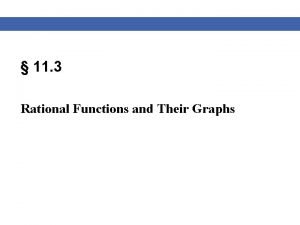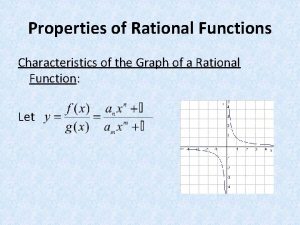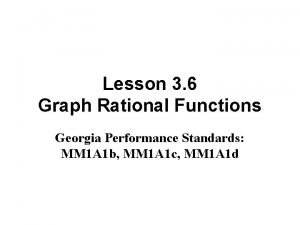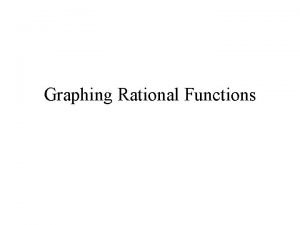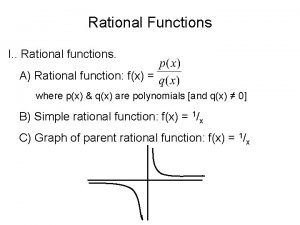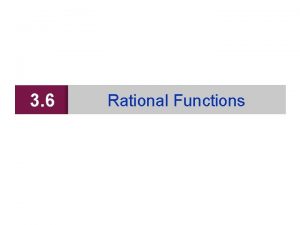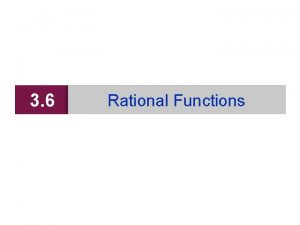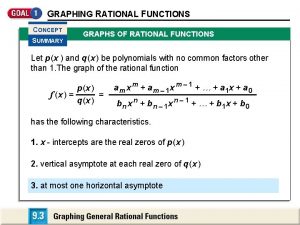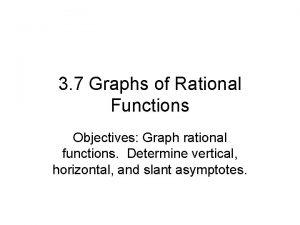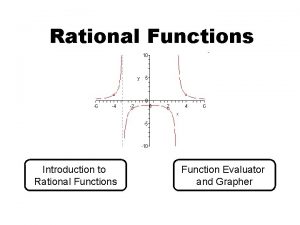Graphs of Rational Functions Goals Graph rational functions























- Slides: 23

Graphs of Rational Functions Goals: -Graph rational functions in the form f(x) and g(x) are polynomial functions. -Draw conclusions about graphs in 3 ways: where both -Analytically: finding asymptotes with algebra -Numerically: supporting and generating conclusions with the table of values -Graphically: a visual look at the behavior of the function. -Find vertical and horizontal asymptotes in rational functions. -Graph rational functions with asymptotes.

A rational function is a function that can be expressed in the form where both f(x) and g(x) are polynomial functions. Examples of rational functions would be: Over the next few frames we will look at the graphs of each of the above functions.

Example 1: Non-permissible value? If you guessed x = 2, congratulations! At x = 2, the function is undefined (because x = 2 generates 0 in the denominator. ) Consider the graph of the function. What impact do you think this forbidden point will have on the graph?

Fill in the values in the table below. x 1. 5 -2 1. 7 -3. 33 1. 9 -10 2. 0 undefined As we pick values of x that are smaller than 2 but closer and closer to 2 what do you think is happening to y? y is getting closer and closer to negative infinity

Now fill in the values in the rest of the table. x 1. 5 -2 1. 7 -3. 33 1. 9 -10 2. 0 Und 2. 1 10 2. 3 3. 33 2. 5 2 What about the behavior of the function on the other side of x = 2? As we pick values of x that are larger than 2 but closer and closer to 2 what do you think is happening to y? y is getting closer and closer to positive infinity

The graph so far. . . What is the equation of this dotted line? x=2

The line x = 2 is a vertical asymptote.

Our graph will get closer and closer to this vertical asymptote but never touch it. If f(x) approaches positive or negative infinity as x approaches c from the right or the left, then the line x = c is a vertical asymptote of the graph of f.

A horizontal asymptote is a horizontal line that the graph gets closer and closer to but never touches. The official definition of a horizontal asymptote: The line y = c is a horizontal asymptote for the graph of a function f if f(x) approaches c as x approaches positive or negative infinity. Huh? ! Don’t you just love official definitions? At any rate, rational functions have a tendency to generate asymptotes, so lets go back to the graph and see if we can find a horizontal asymptote.

Looking at the graph, as the x values get larger and larger in the negative direction, the y values of the graph appear to get closer and closer to what? The y values get closer to 0. Let’s look at a table of values for confirmation.

Calculate the y values in the table below. x 0 -(1/2) -5 -(1/7) -20 -(1/22) -100 -(1/102) Conclusion: as the x values get closer and closer to negative infinity, the y values will get closer and closer to 0. Question: will the same thing happen as x values get closer to positive infinity?

How about a guess? What do you think is going to happen to the y values of our function as the x values get closer to positive infinity? As As Very large values of x will generate values of y very close to 0.

Note how the graph is very much dominated by its asymptotes. You can think of them as magnets for the graph. It will be very important to know where your asymptotes are before you start plotting points. Vertical Asymptote at x = 2 Horizontal Asymptote at y = 0.

Example 2: Pick out the asymptotes analytically before we start plotting points in a table of values. Do we have a vertical asymptote? If so, at what value of x? At x = 3 (because at that value of x, the denominator is 0 but the numerator is not). The horizontal asymptote is a little more challenging…

Notice though that as values of x get larger and larger, the 3 in the denominator carries less and less weight in the calculation. As the 3 “disappears”, the function looks more and more like… which reduces to y = -2. So, we have: -horizontal asymptote at y = -2. (we think) -vertical asymptote at x = 3. What to do: -set up the table with values close to x = 3 (to the left and right) -also use a few large values of x (to see if the corresponding values of y will be close to y = -2 and confirm the horizontal asymptote)

x -5 -10/8 = -1. 25 0 0 2. 5 5/. 5 = 10 3 Undefined 3. 5 7/-. 5 = -14 5 10/-2 = -5 10 20/-7 = -2. 86 50 100/-47= -2. 13 Take a few minutes and work out the y values for this table. As expected, y values tend to become very large when they get close to the vertical asymptote at x = 3. Also, as x values get large, y values get closer and closer to the horizontal asymptote at y = -2.

Here is the graph with most of the points in our table. Vertical asymptote at x = 3. Horizontal asymptote at y = -2.

Believe it or not, you are now sophisticated enough mathematically to draw conclusions about the graph three ways: Analytically: finding asymptotes with algebra!! Numerically: supporting and generating conclusions with the table of values Graphically: a visual look at the behavior of the function. If your conclusions from the above areas do not agree, investigate further to uncover the nature of the problem.

Example 3: First, look for asymptotes (as it is a rational function). Set the denominator equal to 0. We may have vertical asymptotes at x = 0 and at x = 2. Check with a table of values.

x -2 0 -1 -1 -. 5 -3 -. 1 -19 0 Und 1 3 1. 5 2. 33 1. 9 2. 05 2 und Notice that as x values get closer and closer to 0, the y values get larger and larger. This is appropriate behavior near an asymptote. But as x values get closer and closer to 2, the y values do not get large. In fact, the y values seem to get closer and closer to 2. If x = 2 creates 0 in the denominator why don’t we have an asymptote at x = 2?

No asymptote at x = 2 because when x = 2 both the numerator and the denominator are equal to 0. We should have reduced first. Factor and simplify! Does this mean that and are identical functions? Yes, at every value of x except x = 2 where the former is undefined. There will be a tiny hole in the graph where x = 2.

Look for horizontal asymptotes. -look at y values as x approaches ±infinity. The denominator and numerator will both get very large You can verify this in the table. x As x gets large… 10 1. 2 100 1. 02 1000 1. 002 So, we have a horizontal asymptote at y = 1.

Summary Graph for Example 3: -vertical asymptote at x = 0, -a hole in the graph at x = 2 -horizontal asymptote at y = 1. Hole in the graph. Horizontal asymptote at y = 1. Vertical asymptote at x = 0.
 Strategic goals tactical goals operational goals
Strategic goals tactical goals operational goals Strategic goals tactical goals operational goals
Strategic goals tactical goals operational goals Polynomial function form
Polynomial function form Asymptote rules
Asymptote rules Vertical answer
Vertical answer Sketch the graph of the following rational function
Sketch the graph of the following rational function What are the properties of rational functions
What are the properties of rational functions Horizontal asymptote
Horizontal asymptote Lesson 3 rational functions and their graphs
Lesson 3 rational functions and their graphs State graphs in software testing
State graphs in software testing Speed and velocity
Speed and velocity Graphs that enlighten and graphs that deceive
Graphs that enlighten and graphs that deceive Graph rational functions
Graph rational functions Graph general rational functions
Graph general rational functions General goals and specific goals
General goals and specific goals Motivation in consumer behaviour
Motivation in consumer behaviour Rational graphs
Rational graphs Rational function examples in real life
Rational function examples in real life Networks and graphs: circuits, paths, and graph structures
Networks and graphs: circuits, paths, and graph structures Indirect variation graph
Indirect variation graph Algorithmic graph theory and perfect graphs
Algorithmic graph theory and perfect graphs Representing graphs and graph isomorphism
Representing graphs and graph isomorphism Representing graphs and graph isomorphism
Representing graphs and graph isomorphism Graphs of trig functions
Graphs of trig functions





